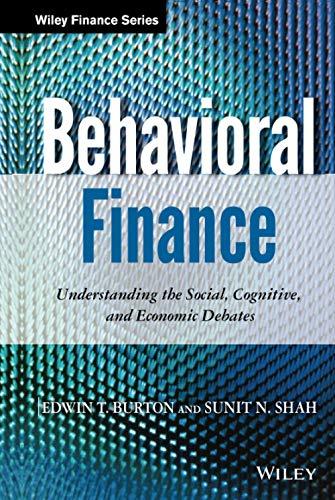Question
Corporate Bonds - They Are More Complex than You Think: When John Sullivan was hired as chief investment strategist at the New York headquarters A.
Corporate Bonds - They Are More Complex than You Think:
When John Sullivan was hired as chief investment strategist at the New York headquarters A. M. Smith Inc. , he had indicated that one of his main goals would be to significantly expand the fixed - income unit of the firm's overall investment portfolio, A. , M. Smith, Incorporated, a prestigious investment services firm, had branches in 28 major metropolitan cities across the United States, as well as a few overseas branches in the United Kingdom, Canada, Singapore, and Australia. The size and performance of its equity portfolio ranked it in the top 10% of all investment companies Worldwide, due due to its excellent customer relations, research staff and client support services. However, with the recent, prolonged drop in interest rates, a constant surge in fixed - income underwriting looks seemed to be circling around the firm's radar. | John realized that the firm's client base, although pretty knowledgeable about equity investing, would need to be adequately informed, trained, and educated about the finer nuances of fixed income investing if he stood any chance of attaining his goal. So, he hired Jill Dougherty, who had worked for a bond trading firm for almost 10 years, prior to going back to Wharton full-time to earn her MBA degree this past year. She also managed to pick up her CFA design along the way. John told Jill that her first major assignment would be to conduct educational seminars / workshops for current and prospective clients regarding the basic and advanced aspects of fixed income investing. With about 75% of our clients being in the 55 + age group, Jill, you should have no problem in signing these folks up for these workshops, and convicting them about the stability and earnings potential associated with corporate bond investing, stressed John, as he browsed through the spreadsheet containing the contact information of the firm's Wealthiest Investors, "You would, however, have to indoctrinate them about the various terms and features associated with these bonds, such as yield to maturity, call provisions, convertibility, duration , convexity, and the like, he added. With the $ 55 - million utility bond deal hanging in the balance, any help we can give our best clients in understanding the relative investment merits of this deal will certainly go a long way in generating a ton of fixed - income business for the firm, dont you think? "Queried John. You bet! "Jill, as she contemplated John's statements," replied, "I'll get right to work on these workshops, John. - Income investing workshops by surveying sarape of the firm's best clients regarding their merits of key bond testis, features, and characteristics. , motivated, and interested they were to know more about the opportunities offered by bond investing. Jill knew that she would have a good turnout at the seminar. in her PowerPoint presentation. She downloaded current data for outstanding bonds of various maturities, ratings, and coupon rates (see Table 1)
| Issuer | Face Value | Coupon Rate | Rating | Quoted Price |
| ABC Energy | $1,000 | 6% | AAA | $809.10 |
| ABC Energy | $1,000 | 0% | AAA | $211.64 |
| Trans Power | $1,000 | 10% | AA | $1025.00 |
| Telco Utilities | $1,000 | 12% | AA | $1300.00 |
1. Why is there so much variation in the coupon rates and prices of these various bonds?" requests one of Jill's wealthiest clients. How should Jill respond?
2. "How are corporate bond ratings determined?" requests another client, "And how and why do these ratings change once they are arrived at?" What should Jill say?
3. During the presentation, one client is confused about the fact that some of these bonds sell for less than their face value, while others sell at a premium. She asks whether the cheaper bonds are a bargain. How should Jill go about clearing up her confusion?
4. During the survey stage, a majority of the firm's clients had no idea about yield to maturity. Using the example of the bonds listed in Table 1, explain what this term means and how one can go about calculating it.
5. During the slideshow, Jill often made reference to a corporate bond's coupon rate and its yield to security, confusing some clients about the definition and interpretation of each term. How should Jane explain the difference between coupon rate and yield to maturity for each listed in Table 1? Which one should the investor use when deciding between corporate and other securities of similar risk? Please explain.
6. How should Jill go about explaining the riskiness of each bond?
Step by Step Solution
There are 3 Steps involved in it
Step: 1

Get Instant Access to Expert-Tailored Solutions
See step-by-step solutions with expert insights and AI powered tools for academic success
Step: 2

Step: 3

Ace Your Homework with AI
Get the answers you need in no time with our AI-driven, step-by-step assistance
Get Started


